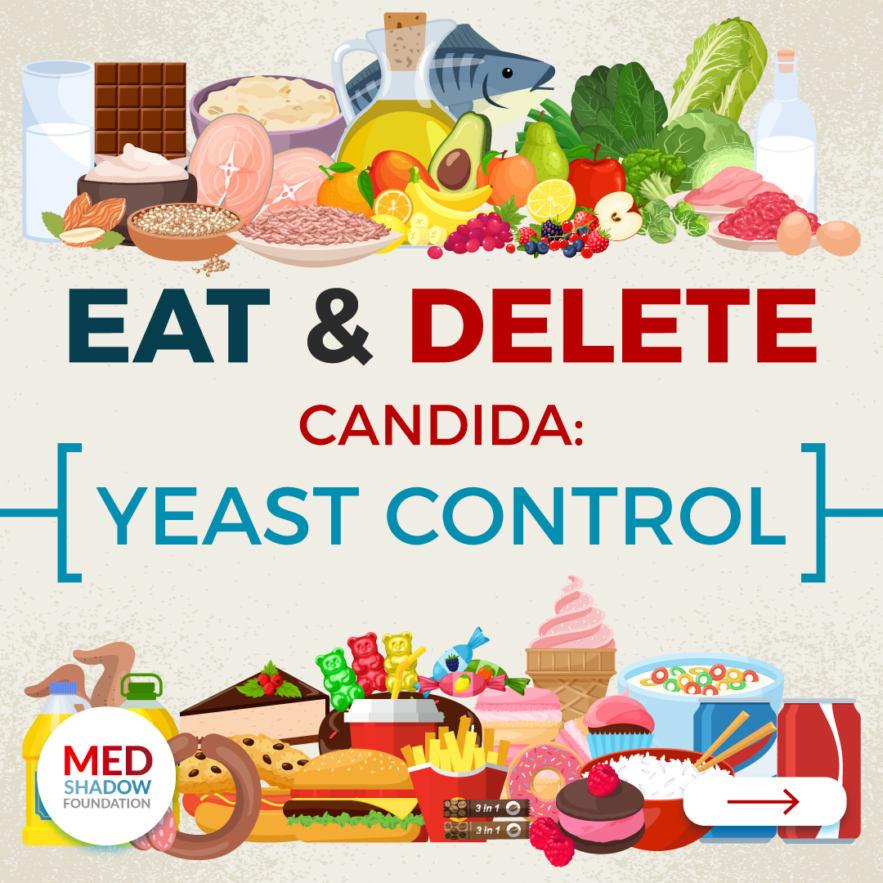If you’ve ever experienced Candidiasis, which is a fungal infection due to overgrowth of yeast that lives on your body (scientifically named “Candida albicans”), you know how unpleasant it can be. The fungus lives in small amounts on your body naturally, typically in the areas of the mouth, vagina, or on your skin. Healthy bacteria also naturally found on and in your body typically keeps the growth of such yeast at a slow, and natural, growth rate. What you eat can help too! Here’s what to eat to manage candida overgrowth.
However, at times, things like a weakened immune system, a poor diet, or certain medical conditions can cause overgrowths of this yeast, thus resulting in an infection. As with many systems in your body, a balance of bacteria and yeast like Candida albicans, are all a very delicate balance. When either side is disrupted, it can wreak havoc on the body and push you into a fungal infection.
Symptoms of Candida Overgrowth (Candidiasis)
It can be difficult for some to tell when their fungal growth is too much, or entering a state known as “overgrowth”.” This overgrowth is considered an infection, as your body is producing too much yeast for the natural bacteria to handle.
Some of the common symptoms of Candidiasis include:
- Bloating
- Gastrointestinal distress
- Stomach irritation
- Rashes on the skin
- Frequent vaginal yeast infections
- Thrush (white coating of the tongue)
- Chronic fatigue
How Does Diet Impact Fungal Infection?
Our bodies work as machines, with each system of organs and functions relying on the next to work in harmony. Just like your “scale” balancing bacteria and fungal growth, so too is your digestive system balancing its contents for optimal use. Our gut health has naturally occurring and helpful bacteria in its biome that helps to reduce the fungal growth. If either side of that equation is off, one will grow more rapidly than intended.
What you eat can help to keep that scale balanced, ensuring your gut health stays in harmony, working as intended. When your diet is high in fat and sugar and/or low in vegetable fiber, you are going to have an imbalance on your digestive “scale.” That means that your diet can help control candida overgrowth.
MedShadow Medical Advisory Board Member and Registered Dietician Alison Acerra, explains some of the diet tips that can help to keep your fungal growth at bay, reducing your risk for Candidiasis. Overall, she says, an anti-Candida diet emphasizes low-sugar, antiinflammatory foods. The goal is to use your diet to eliminate an overgrowth of yeast, and bring the body back into a balanced state.
Foods to Add to Your Diet for Better Balance
1. Add More Non-Starchy Vegetables
Non-starty vegetables like green leafy vegetables, spinach, kale, broccoli, and cauliflower are necessary to bring fiber back into the gut biome. This will help to slow the growth of yeast, encourage the healthy bacteria, and bring the body back toward balance.
2. Increase Non-Sugary Fruits
Fruits like lemons, limes, and avocados can help to balance gut biomes.
3. Try Gluten-Free Grains
Gluten-free grains like quinoa, millet, and buckwheat provide health fiber and nutrition.
4. Healthy Proteins
Meat, fish, chicken and eggs will bring protein to your body without adding to a growth of more yeast.
5. Dairy Products Lower in Lactose
Like probiotic yogurt and kefir are permitted, though most dairy products are off limits.
6. Limit the ‘OK List’ Foods
Acerra says if you must use sweeteners, things like stevia and monk fruit are “on the OK list.” She says it is still best to reduce sugars (even artificial ones) as much as possible.
“Drinks like chicory coffee and herbal teas” also fall on an “OK list” as drinks that can keep the system balanced or neutral.
Foods to Delete From Your Diet
Some foods promote candida overgrowth. These are the ones that are crucial to avoid. To allow your body to self-regulate and return to a more even keel, you will want to remove foods from your diet that promote growth.
1. Eliminate Foods High in Sugar
Candida needs sugar to grow. Sugar also helps Candida to “hide’ from your immune system. Eliminating it from your diet as much as possible will limit the yeast’s “food source,” allowing the overgrowth to slow or stop.
“It doesn’t matter if this sugar comes from processed foods or the natural sugars that we find in fruits and juice,” says Acerra. “That is why sugary snacks, high-sugar fruits and juices are all on the avoid list.”
2. Reduce Foods That Contain Gluten
“In some people, gluten can cause inflammation of the gut, worsening intestinal permeability,” says Acerra. “That can worsen Candida symptoms.”
Gluten-containing grains like wheat, barley, and rye are ones to remove from your diet if concerned about Candida overgrowth.
3. Cut Back on Foods that Promote Gut Inflammation
Typically foods that are highly processed, with additives and preservatives, such as packaged snacks, sweets, chips, or candy all inflame your gut. This again promotes Candida overgrowth, as your intestines are unable to absorb the proper nutrients for a healthy balance. Eliminating these foods will reduce overgrowth.
Food Is Medicine
It is important to include foods that are low in sugar, gluten, and inflammatory properties in order to create a balance in the gut and increase the probability of a healthy immune system. Watching what you eat has a massive impact on how your body is able to handle its most basic of functions.
Adding the right foods and eliminating some of the wrong ones can go a long way in treating your condition.
“These foods will help to keep Candida overgrowth in check,” says Acerra.







